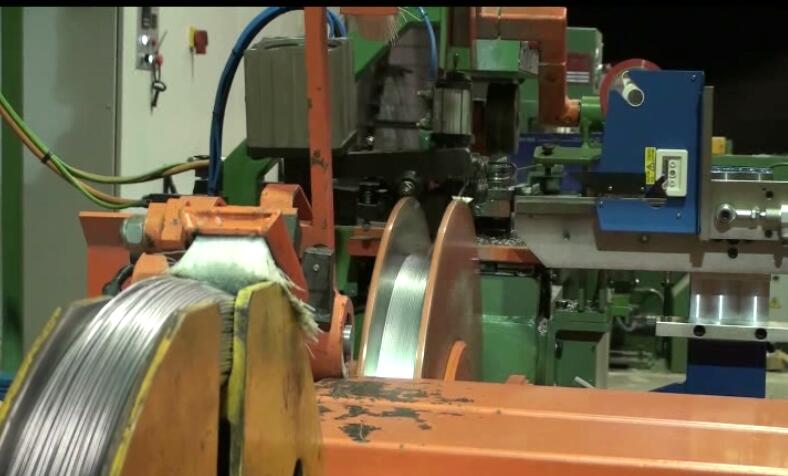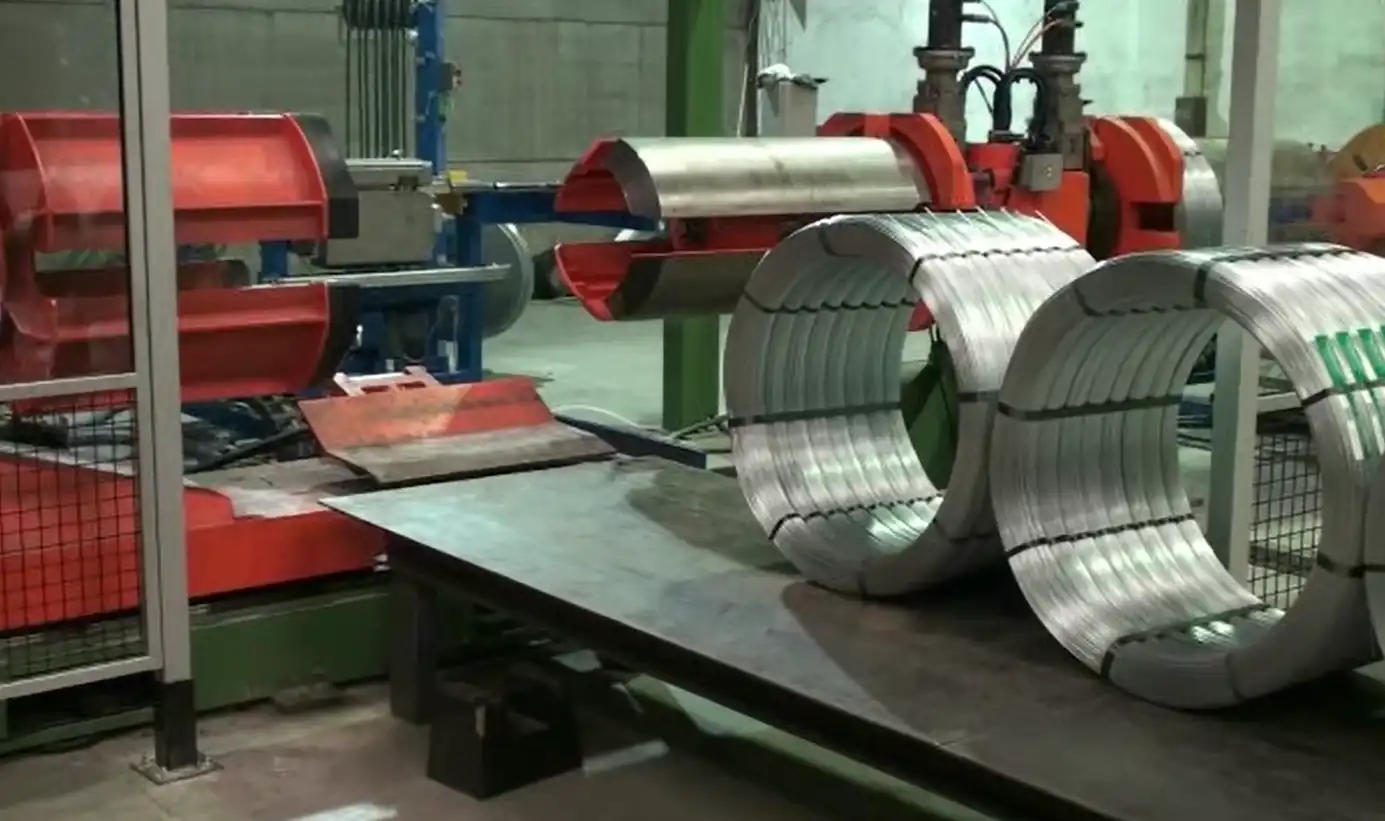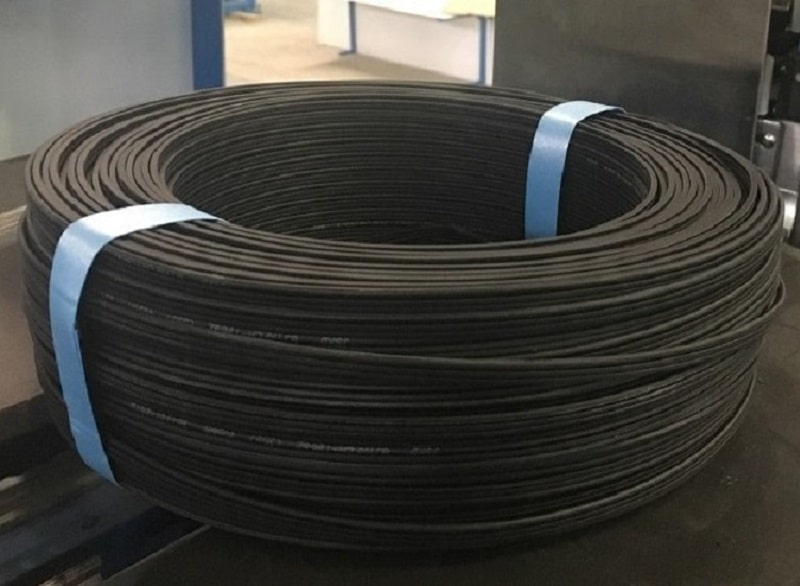I've walked through countless factory floors in my career. I often see the same story playing out at the end of the production line. Highly efficient machines are churning out quality steel wire at an impressive rate, but then everything grinds to a halt at the packing station. Here, you see workers struggling to manually coil heavy, awkward wires. The process is slow, the results are inconsistent, and you can see the pressure building as finished products pile up, waiting to be shipped. This bottleneck doesn't just slow down one order; it ripples through your entire operation, causing delays, frustrating your team, and putting your delivery promises at risk. You know you can produce more, but you feel trapped by this final, manual step.
A steel wire coiling machine directly enhances warehouse productivity by automating the slow, inconsistent, and labor-intensive task of coiling. This automation leads to significantly faster and more predictable cycle times, uniform package quality, and reduced reliance on manual labor. By eliminating a major bottleneck, the machine allows your entire production line to operate closer to its true capacity, boosting overall output and throughput.

It’s easy to say a machine makes things faster. But for a factory manager like Michael, who I speak with often, the real value is in the details. It's about how this one piece of equipment can solve multiple, interconnected problems that you face every single day. The benefits go far beyond just speed. They touch on safety, product quality, and ultimately, your bottom line. So, let's break down exactly how these machines transform a warehouse from a chaotic bottleneck into a streamlined, productive asset.
How Can a Steel Wire Coiling Machine Eliminate Packing Bottlenecks?
Does your packing area feel like a traffic jam? Production is running smoothly, but the packing team just can't keep up. Pallets of finished wire start to crowd the aisles, waiting to be coiled and strapped. This situation is more than just an inconvenience. It creates a critical blockage that holds up shipments, makes it nearly impossible to meet tight customer deadlines, and adds a layer of stress and chaos to the entire shop floor. It feels like you’re running a race with one leg tied. The solution is to untie that leg by introducing a machine that works not at a human pace, but at a consistent, mechanical speed that matches your production output.
A steel wire coiling machine eliminates these bottlenecks by replacing the variable, and often slow, pace of manual work with a fast, continuous, and highly predictable automated process. Its main job is to synchronize your packing speed with your production speed, creating a smooth and uninterrupted flow of materials from the moment they are made to the moment they are shipped.

The Critical Difference in Speed and Consistency
The most obvious advantage is raw speed. A manual worker, no matter how skilled, can only coil a certain amount of wire per hour. They get tired, they need breaks, and their pace can vary. A machine does not. It can operate 24/7 at a consistent, programmed speed. For example, where a worker might produce 10-15 coils per hour, a basic automatic coiling machine could easily produce 30-40 or more, depending on the wire diameter and coil size. This isn't just a small improvement; it's a fundamental change in your capacity.
But consistency is just as important as speed. Manual coils can vary in size, shape, and tightness. This inconsistency creates problems down the line for strapping, wrapping, and palletizing. A machine, however, produces a nearly identical coil every single time. This uniformity makes all subsequent packing steps faster and more reliable, further reducing delays.
Integrating for a Truly Automated Workflow
A modern coiling machine is not just a standalone unit. To truly eliminate a bottleneck, it must work as part of a system. I always advise my clients to think about the entire end-of-line process. A coiling machine can be integrated with powered conveyors that feed the wire, automatic strapping machines that secure the coil, and orbital wrappers that apply protective film. This creates a seamless, hands-off system. The wire comes in, and a perfectly coiled, strapped, and wrapped product comes out, ready for the forklift. This is the "Total Solution" philosophy in action. It transforms the packing station from a collection of separate tasks into one single, efficient process.
Using Data to Your Advantage
As an engineer and a factory owner, I love data. It helps you make smart decisions. Many modern coiling machines come with programmable logic controllers (PLCs) and human-machine interfaces (HMIs) that provide valuable production data. You can track the number of coils produced per shift, monitor cycle times, and get alerts for maintenance needs. For a manager, this data is gold. It allows you to accurately measure your output, identify potential issues before they become major problems, and plan your production schedules with much greater confidence. You're no longer guessing about your packing capacity; you know it.
| Metric | Manual Coiling | Automated Coiling | Impact on Bottleneck |
|---|---|---|---|
| Speed (Coils/Hour) | 10-15 (Variable) | 30-60+ (Consistent) | Drastically increases throughput. |
| Consistency | Low (Varies by worker) | High (Identical coils) | Simplifies downstream processes. |
| Labor Requirement | High (1-2 workers per station) | Low (1 operator for multiple lines) | Frees up staff for other tasks. |
| Operational Hours | Limited by shifts/breaks | Can run 24/7 | Maximizes production time. |
| Downtime | Unplanned (Fatigue, error) | Planned (Scheduled maintenance) | More predictable operation. |
How Do Automated Coiling Machines Improve Workplace Safety and Reduce Labor Costs?
Think about the physical act of manually coiling steel wire. It involves repetitive lifting, twisting, and pulling on heavy materials. Every time one of your workers bends down to handle a heavy coil, you know there's a risk of a back injury, a muscle strain, or worse. This constant worry about a serious accident is a heavy burden for any manager. The consequences are real: high workers' compensation insurance premiums, frequent employee turnover in a physically demanding role, and the significant direct and indirect costs of a workplace injury. Automation offers a direct path to removing your team members from this line of fire, fundamentally changing the safety profile of your warehouse.
Automated coiling machines dramatically improve workplace safety by taking the human element out of the most physically strenuous and dangerous parts of the job. The machine does all the heavy lifting, coiling, and cutting. This simple change almost completely eliminates the risk of musculoskeletal injuries associated with manual handling. At the same time, by reducing the need for manual laborers at the packing station, you directly lower your payroll and associated labor costs.

Understanding the True Cost of an Unsafe Process
The cost of an injury goes far beyond the immediate medical bills. When a worker gets hurt, you face potential downtime on the line, the cost of hiring and training a replacement, and a negative impact on team morale. Your insurance premiums will likely increase. These are the hidden costs that eat away at your profitability. I remember early in my career, working in a factory, a colleague suffered a serious back injury while handling a heavy product. The entire line stopped. The incident stuck with me, and when I started my own factory, safety was my number one priority. Investing in automation is not an expense; it's an investment in your people and in the financial health of your company. It's one of the clearest examples of a positive ROI you can find.
Calculating the Financial Impact of Automation
Let's look at the numbers. A manual packing station might require two workers per shift. If you run two shifts, that's four salaries you have to cover. You also have to account for benefits, insurance, and the costs of turnover. An automated line might only require one operator to oversee several machines. The reduction in direct labor costs is immediate and significant. You can then reallocate those skilled workers to less physically demanding and more value-added roles, such as quality control, machine maintenance, or logistics coordination. You aren't just cutting costs; you are making better use of your most valuable asset: your people.
Creating a Better, More Stable Work Environment
A safer workplace is a happier and more stable workplace. High-risk, physically demanding jobs often have high turnover rates. Constantly having to recruit, hire, and train new employees is expensive and disruptive. By automating the most difficult jobs, you create a more desirable work environment. This leads to higher employee retention, which saves you money and builds a more experienced, reliable team. Your employees can focus on operating and maintaining sophisticated equipment rather than performing manual labor. This builds their skills and gives them a career path, which is a powerful incentive to stay with your company. It turns a low-skill, high-risk job into a high-skill, low-risk one.
How Does a Coiling Machine Protect Steel Wire Quality and Reduce Product Damage?
You invest a lot of time and money to produce top-quality steel wire. But what happens if that quality is compromised before the product even leaves your warehouse? I've seen it happen: coils with scratched surfaces from rough handling, deformed shapes from uneven winding, and damaged edges from being dropped or bumped. These issues lead directly to customer complaints, rejected shipments, and costly returns. It damages your bottom line and, more importantly, it damages your company's reputation for quality. The solution is to handle the wire with the same level of precision during packing as you do during manufacturing.
A coiling machine protects steel wire quality by using precise, computer-controlled mechanisms to ensure uniform tension, perfect winding patterns, and gentle handling. This careful process creates dense, stable, and perfectly formed coils that are highly resistant to damage. It minimizes the risk of common defects like scratches, kinks, tangles, and edge damage that often occur during manual handling, internal transport, and final shipping.

The Engineering Behind a Perfect Coil
This isn't just about wrapping wire around a core. There is a science to creating a stable, high-quality coil. Experienced managers and engineers like Michael appreciate this level of detail. A good coiling machine controls several key variables.
First is tension control. The machine maintains constant, optimal tension on the wire as it is being wound. Too little tension and the coil is loose and unstable. Too much tension and you risk stretching or damaging the wire itself.
Second is the traverse system. This mechanism guides the wire back and forth, laying it in a precise, even pattern. This prevents tangling and creates a dense, compact coil that won't shift or collapse.
Finally, the machine handles the wire with smooth, guided movements, avoiding the scrapes and impacts that are common with manual coiling. This technical precision is something that simply cannot be replicated by hand, ensuring every coil meets your quality standard.
Protecting the Product All the Way to the Customer
A well-formed coil is inherently more durable. Its dense, stable structure makes it much easier to handle in the subsequent stages of packing. It can be strapped tighter without deforming. It sits more securely on a pallet. It is less likely to be damaged by a forklift. When you ship a pallet of perfectly uniform coils, they are less likely to shift, rub against each other, or collapse during transit. This means the product that arrives at your customer's door is in the same pristine condition as when it left your production line. This is how you build a reputation for reliability and reduce the headaches of dealing with freight claims and customer complaints.
An Added Layer of Defense Against the Elements
Product damage isn't always physical. Corrosion from moisture and contamination from dirt are also serious threats to steel wire. A tight, dense coil naturally has less surface area exposed to the air. Furthermore, our coiling machines are designed to integrate seamlessly with automatic wrapping systems. After a coil is formed and strapped, it can move directly to an orbital wrapper that applies stretch film or VCI (Vapor Corrosion Inhibitor) paper. This seals the coil, providing a powerful barrier against moisture and contaminants during storage and shipping. It’s another example of how a "Total Solution" approach protects your product quality at every step.
What Should You Look for in a Coiling Machine Supplier to Ensure a Good ROI?
You've decided that automation is the right move. Now comes the hard part. You may have been burned in the past by equipment suppliers who were great at making a sale but disappeared when you needed support. That experience makes you cautious, and rightly so. A bad investment in a machine is not just about the money you lose; it's about the months of operational headaches, production downtime, and frustration it can cause. To avoid this, you need to change your mindset. Don't look for a vendor who sells machines. Look for a partner who provides solutions and understands your world from the inside out.
To ensure a good return on your investment, you must look for a supplier with deep, authentic, hands-on industry experience—not just a polished sales pitch. A true partner will take the time to understand your specific production challenges, offer solutions customized to your needs, guarantee robust after-sales support, and show you a proven track record of helping businesses just like yours become more successful.
Look for a Partner, Not a Salesperson
When I made the leap from being an engineer to starting my own packing machine factory, I learned a crucial lesson. I wasn't just building machines; I was solving the very same problems I had faced on the factory floor. This perspective is everything. A good supplier should act like a consultant, not a salesperson. They should ask you about your line speed, the types of wire you run, your downstream strapping and palletizing processes, and your growth goals. They should want to understand your entire operation. This is my approach at SHJLPACK. I insist on understanding the full picture so we can recommend a solution that truly fits, not just a machine that we happen to have in stock.
After-Sales Support is Not an Option, It's Essential
A machine is useless if it's not running. I know the gut-wrenching feeling of having a critical piece of equipment down and waiting days for a technician or a simple spare part to arrive. It’s why I am so passionate about after-sales support. A reliable supplier doesn't see the transaction as complete when the machine is delivered. They see it as the beginning of a long-term relationship. You should ask potential suppliers detailed questions: Do you stock critical spare parts locally? Can you provide remote diagnostics to troubleshoot problems quickly? What does your training program for our operators and maintenance staff look like? A supplier who can give you clear, confident answers to these questions is one you can trust.
A Partnership Focused on Your Growth
Finally, the right partner is someone who is invested in your success. My own financial independence came from this industry. I built a successful business, and in the process, I helped many of my clients grow their businesses too. Now, my mission is to give back and share that knowledge. My goal isn't just to sell you a coiling machine. My goal is to provide a solution that lowers your costs, improves your safety, and helps you win more customers. When you grow, we grow. That’s the definition of a true partnership. Look for a supplier who talks about your long-term success, not just the short-term sale. This is the difference between buying a tool and making a strategic investment in your future.
Conclusion
Investing in a steel wire coiling machine is more than an upgrade; it’s a strategic move towards a safer, more efficient, and more profitable warehouse operation.




